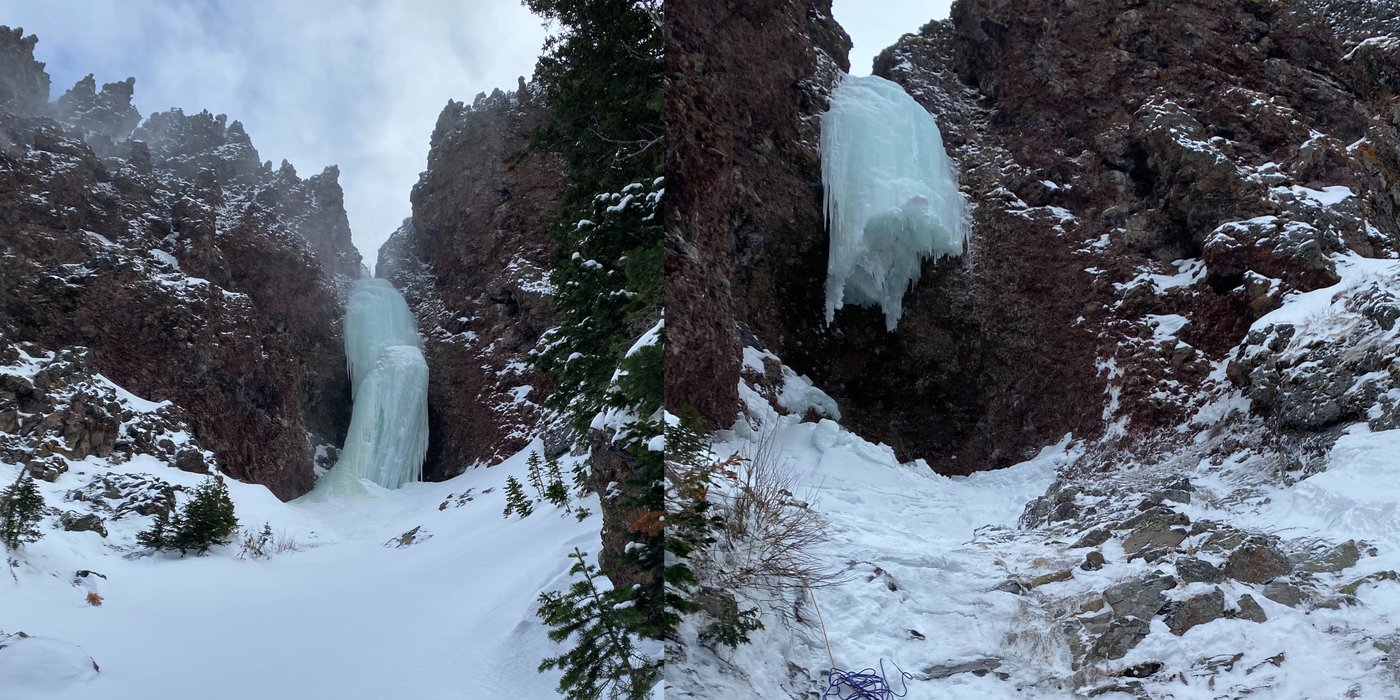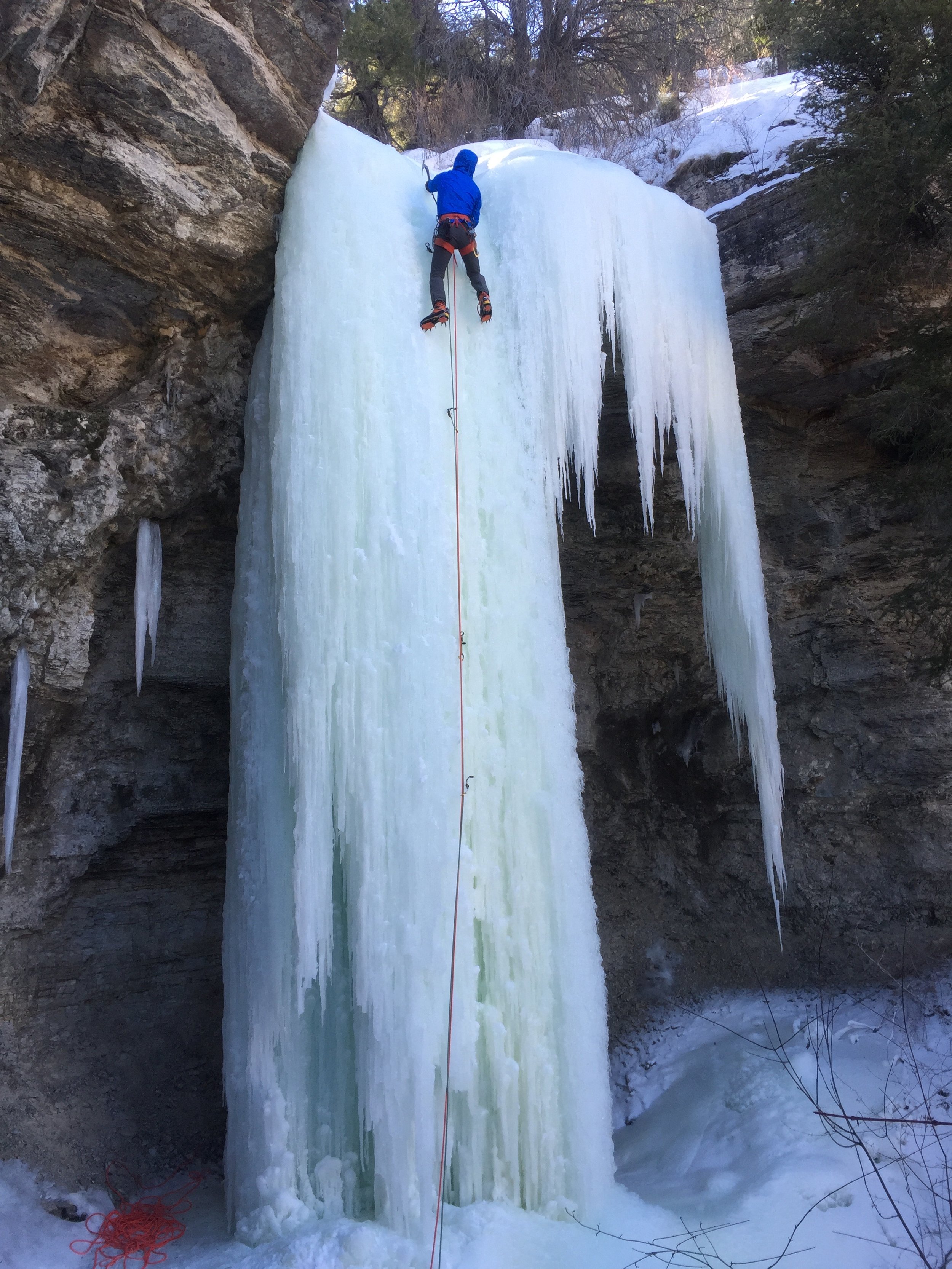The ice and mixed season is in full swing. While offering a dazzling range of sights, sounds, and textures, winter climbing arguably presents the highest risk to life and limb of any crag-oriented climbing genre. Ice is an ever-changing medium. The clothing and tools required deprive climbers of the accustomed “feel” for the climbing medium—so critical to fair-weather rock climbing.
This month we have two accidents from 2023. Both involved collapsing ice formations. One had an injury-free ending. The other ended in tragedy.
Code Red (WI 5) in Hyalite Canyon, before and after a dramatic collapse in January 2023. The two climbers involved in this accident fortunately emerged unharmed. Caption: Photo: Lauren Olivia Smith/Climbing magazine
Fall on Ice | Collapsed Pillar
Hyalite Canyon, Montana
On January 27, 2023, Lauren Olivia Smith and Bailey Lasko, both of Bozeman, Montana, were climbing Code Red (WI 5) in nearby Hyalite Canyon. This single-pitch ice pillar has a longer approach than other popular venues in the canyon. The approach, combined with the avalanche hazard, made for a more serious outing.
Smith was leading. As she reported to Climbing magazine, “(From the approach gully)…the pillar looked funky and off-kilter, in a shape I’d never seen before…. I remember thinking it doesn’t look quite right, but the part that was leaning seemed quite big, and we had a big freeze-thaw [cycle], so I figured it was well-attached.”
From a closer vantage, Smith confirmed that Code Red appeared well-attached to the rock and “gave its stability no further thought.” At 15 feet up, Smith heard a cracking noise from above. The bottom half of the pillar then collapsed, toppling “like a falling tree.” Smith said, “I remember seeing a chunk of ice fall past me with my tool still in it.”
The point of detachment was 35 feet above Smith. With no intermediate protection, she—and the unanchored Lasko—"rocketed down the 30-degree approach slope.” Smith had been climbing on the lower-angled (left) side of the formation, and the inclined column fell away from her, so she avoided being crushed. The pair slid alongside the pillar before self-arresting after 100 feet, and they emerged unharmed.
ANALYSIS
Smith did well to assess temperature patterns in the days prior to the outing. She also chose a line that was well-bonded to the top of the cliff. While Smith was surprised at the collapse, it’s worth noting that the unusual crooked profile indicated the pillar had previously cracked and toppled partway before refreezing at a Pisa-like tilt. Inclined columns are subject to axial compression, shear forces, and in this case, buckling. Smith says she now completes a full 360-degree inspection of any free-standing ice pillar before climbing.
(Sources: Climbing magazine, The Editors.)
Fall on Ice | Collapsed Pillar
Right Fork of Indian Canyon, Duchesne, Utah
On April 2, 2023, Meg O’Neill (40), a member of a party of three climbers, was killed when struck by a collapsing ice column on Raven Falls (WI4), near Duchesne in northeast Utah. According to the Duchesne County Sheriff’s Office, O’Neill, who was standing nearby, saved the belayer’s life by pushing her out of the fall zone. The leader was seriously injured.
Sean McLane (34) was on lead near the top of the second pitch when the accident occurred. He was belayed by Anne Nikolov (21), while O’Neill was spectating.
Sean McLane climbing Raven Falls (WI 4) on an earlier ascent. This two-pitch climb near Duchesne, Utah was the scene of a fatal accident in April 2023. McLane wrote, “On the day of the accident, it looked about the same (as in this photo). Photo: Sean McLane
McLane wrote to ANAC, “It had been warm for a couple days, and this was to be my last climb of the season. We were a group of three. Meg was experienced and a regular climbing partner of mine. Anne was new and had climbed a couple times with Meg.”
McLane led the first pitch and brought the other two up. The base of pitch 2 was a broad snow ledge about 100 feet above the top of the first pitch.
“The second pitch was an ice column that formed at the lip of a cave. The column was 40 feet high and 15 feet in diameter. I saw no signs of instability. I didn’t see or hear any significant running water. There was little to no cone at the bottom, although a 15-foot radius of ice was present at the base. I stomped on it to test for anything being undercut, but it felt solid, likely because it was a couple feet thick and my weight wasn't enough to stress it.”
“I led out the back of the ice and corkscrewed around to the side. Anne (Nikolov) was belaying and Meg (O’Neill) was walking around, taking pictures. As I [was nearly] top[ping] out, there was a significant density change in the ice. It went from wet, one-swing sticks, to dense… dinner-plating [hits]."
McLane climbed above the point where the ice was attached to the rock. As he swung an ice tool into an already dinner-plated placement, the pillar fractured, breaking two or three feet below the point of the pick’s impact.
According to McLane, the collapse took “my other tool and both my feet with it. Meg was in the cave behind the pillar, and Anne was to the side. Most of the column went downhill, but falling ice buried Meg.”
Climbing magazine wrote that O’Neill “noticed the ice fracture, and… may have heard it cracking just before the formation broke.” She then pushed Nikolov aside, and as also reported in Climbing magazine, “Her quick thinking undoubtedly saved Anne’s life.”
McLane recalls, “I had placed screws in the pillar and was pulled off by the rope. The main column fell down the slope away from me, and I came straight down. "I hit the ground... land[ing] on my back [atop] a large chunk of ice. [This] broke my spine at L2... That was my only injury besides scrapes and bruises. I put myself in recovery position as Anne tried to get to Meg.”
The closest cell signal was driving distance away. McLane showed Nikolov how to fix a rappel line and then gave her his phone along with directions to access the car keys. Nikolov safely descended, drove to town and contacted SAR and local climbers. About six hours after the accident, some Salt Lake climbing friends arrived. McLane was long-lined by helicopter to the road. He was then loaded into another helicopter and flown to a hospital in Salt Lake City.
*Editor’s Note: This is an example of a hidden ice climbing hazard called a False Pillar. To learn more, click the link below.
ANALYSIS
Alpinism and ice climbing are perhaps the most dangerous of climbing games. As mentioned above, frozen water is a fickle, ever-changing medium. And, as demonstrated in these two accidents, the hazards are often invisible. In no small way, luck was a determinant factor in the different outcome of these two accidents.
On Raven Falls, McLane—a very experienced climber who had safely climbed the route twice previously—visually assessed the ice and stomp-tested the base to ensure the column was attached. He wrote to ANAC that, “In retrospect, to fail as it did, the pillar must have been melted out from underneath.” The solid-looking column was basically a free-hanging, bus-sized chunk of ice.
McLane has physically recovered; it took about six months to get back to normal climbing.
McLane notes:
Running water underneath an ice formation can render a solid and fully attached flow free-hanging and unstable. Figuring out if ice is undercut can be hard to impossible to do, without seeing the running water or the gap between the bottom of the pillar and the base. Several days of warmer temperatures can create this dangerous situation.
Large variations in ice quality and density (on the route) may signal stability issues.
(When belaying or spectating) Position yourself farther away than you might think in order to stay out of the way of falling ice. A cave is not necessarily protected if the ice collapses.
Carry an extra layer (pack it with you on your harness or in your pack). Since it was a warm day, I left my puffy at the base, a pitch below. I got very cold lying on ice and not moving for many hours.
If you might need something on a multi-pitch route, don’t leave it at the base. A satellite communicator and warm layers with me on pitch two would have made a bad situation more manageable.
(Source: Sean McLane, Climbing magazine, and The Editors.)
To Climb or Not to Climb?
More people than ever are ice climbing. At the same time, climate change is dramatically affecting geologic stability in the mountains. Changes include rock fall, glacial recession, and waterfall ice collapse. The intersection of ice climbing popularity and effects of climate change can cause accidents.
This flowchart was developed by Derek DeBruin. It was first published in the 2023 ANAC. This tool can assist in managing hazards by helping determine the stability of the ice, the effectiveness of ice screw protection, and the quality of ice tool placement. Downloadable PDF and image are available through the link below.
The Prescription is the monthly newsletter of Accidents in North American Climbing. The Prescription brings you monthly unpublished accident reports, tech tips, links to new online educational resources, and much more—all aimed at helping you become a safer climber.




